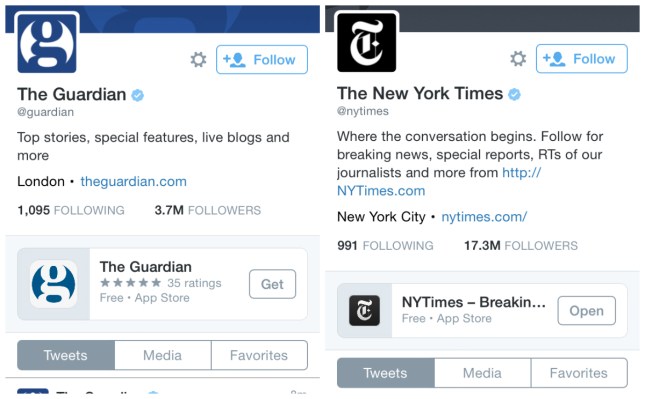While Apple is rethinking how it aggregates, filters and presents news to iPhone and iPad users, Twitter is also sharpening its focus on news media. We have found that the social network is currently running a new kind of app install “card” on the mobile versions of profile pages for select news sites, which gives users the ability to install the sites’ apps.
We first noticed the feature appear in our iPhone Twitter app on the profile page for The New York Times, and then later also found it at the top of the Guardian’s Twitter account. Twitter is also testing it on its own properties: we also then found it on Vine’s and Periscope’s profile pages. Twitter has confirmed that it’s an experiment, one of the many that Twitter goes through as it works out new products for the platform.
“It appears you stumbled upon one of the many small-scale experiments we routinely run while considering improvements to the Twitter user experience,” a representative from Twitter’s news team wrote to our social media editor, Travis. “Unfortunately we don’t have further information to share on this one.”
Separately, a spokesperson told us, “I can confirm that we’re experimenting with an app install card.”
App install ads have proven to be a big deal for companies like Facebook, which makes billions on mobile ads, with a large proportion of that coming specifically from app ads. Part of the reason that app install ads are doing well is is because of how broken discovery is in app stores. There is too much there and unless you know specifically what you are looking for (and sometimes even if you do), it’s hard to find what you want or need.
Sites like Facebook, but also Twitter and others, have captive (anonymised) audiences whose preferences they are able to track by way of what they read, like and engage with on their sites. This data, in turn, can be used to provide a more targeted stream of app suggestions to those users.
But this latest experiment is even more direct that that: if you like The New York Times enough to check out its Twitter profile page, or if you navigate there from somewhere else, then why not show you a card to download the NYT app?
In the scramble to capitalise on app install ads, perhaps before all of us confront app install ad fatigue, Twitter has gone through other formats, too, experimental and otherwise. They have included a carousel of app install ads, as well as more standard mobile app promotion in the the Timeline, introduced almost exactly a year ago.
This latest experiment is a bit different, in that it’s not presented as a promoted ad, but a card. Cards are used by developers to enhance Tweets with photos, app downloads and media. Twitter also offers commercial cards, such as these for lead generation. The experiment here currently looks more like a free card, in that there is no “promoted” icon on the link promoting the app download.
Twitter, more generally, has been confronting a much wider set of changes both in recent times and over the last several quarters.
Twitter last week swapped out Dick Costolo as the CEO as it searches for a permanent replacement, in the midst of a sagging stock price and the company grappling with bigger questions about how to develop its business.
Twitter has been on a march to figure out how to grow its visitors with a service that is easier to engage with if you’re a newcomer and not of the power-user inclination. It will be interesting to see what other enhancements it might try out for high-profile Profile pages, turning them into more of a set of landing pages.
And it is also working on ways of better playing up what it already has. Twitter has been a clear leader, and has played up, its position in news and media, with many people flocking (heh) to the site during major events to gauge real-time reactions from others, and also to weigh in themselves. That’s a path the social network is likely to continue to beat, regardless of who is at the helm.
Updated with more information about the difference between ads and cards.
